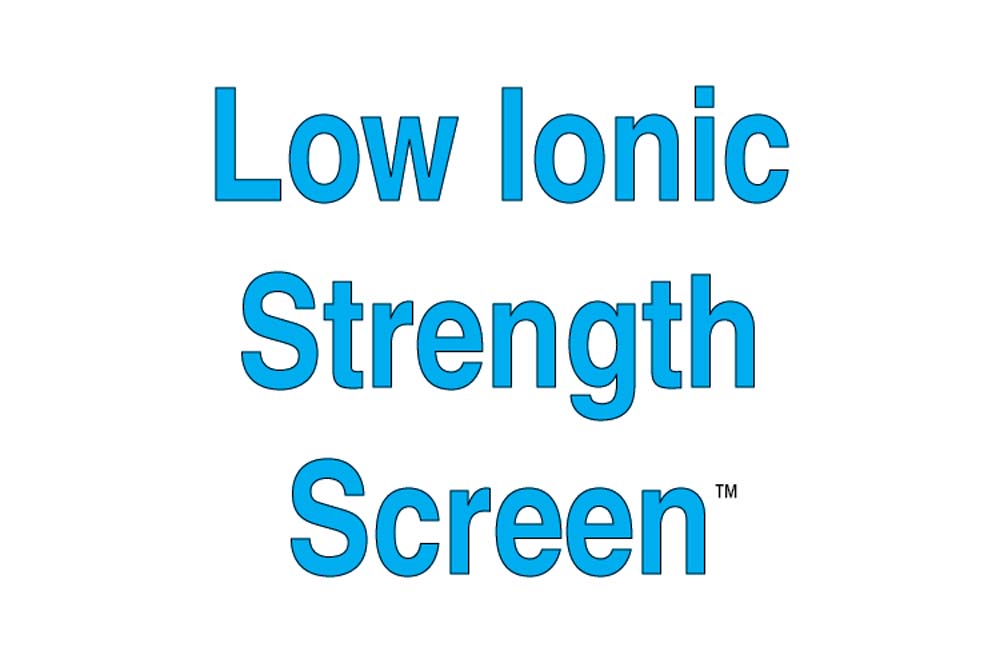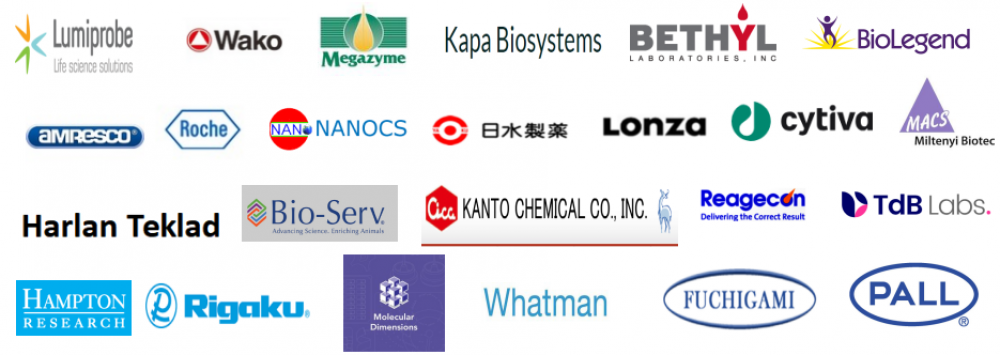Hampton–Low Ionic Strength Screen (LISS) 低离子强度屏幕
上海金畔生物代理Hampton research品牌蛋白结晶试剂耗材工具等,我们将竭诚为您服务,欢迎访问Hampton research官网或者咨询我们获取更多相关Hampton research品牌产品信息。


Products > Crystallization Screens > Low Ionic Strength Screen > Low Ionic Strength Screen (LISS)
Low Ionic Strength Screen (LISS)
Applications
- Crystallization screen for intact monoclonal antibodies, monoclonal antibody fragments, & proteins less soluble at low ionic strength
Features
- Screen a complete pH profile (2-12) at low ionic strength
- Requires only 25-110 microliters of sample.
- Enhanced temperature effects due to low ionic strength
- Monodisperse PEG 3,350
Description
The Low Ionic Strength Screen is effective in determining the preliminary crystallization conditions of intact monoclonal antibodies.1 However, this screen is not just an intact antibody screen. The screen has effectively determined the preliminary crystallization conditions for numerous monoclonal antibody fragments as well as other soluble proteins.
The screen should be utilized as a low ionic strength crystallization screen for proteins where this strategy could be effective in determining preliminary crystallization screens.
In this screen, the concentration of a high purity, monodisperse PEG 3,350 is varied from 4 to 24% w/v (4, 8, 12, 16, 20 and 24% w/v) versus a pH range of 2 to 12 (2, 3, 3.5, 4, 4.5, 5, 5.5, 6.0, 6.5, 7, 7.5, 8, 8.5, 9, 9.5, 10, 11, 12). Stock buffer concentrations are 50 mM. Final buffer concentration in the drop is typically 10 mM.
Unique features of this screen: (1) Low ionic strength. Buffer concentration is supplied as 50 mM, resulting in an initial drop concentration of 10 mM (Drop = 4 µl sample, 2 µl buffer, 5 µl precipitant). (2) The Polyethylene glycol (PEG) 3,350 is a special, high-purity, monodisperse preparation with an Mr of 3,300-3,400. Most PEGs of this molecular weight have an Mr of plus or minus 500 rather than 50. (3) An extremely broad range of pH 2 to 12 is sampled. At low ionic strength, the effects of pH and temperature upon sample solubility are amplified. Hence this screen allows one to critically evaluate the effects of temperature and pH upon sample solubility and crystallization. It is recommended the screen be repeated at several temperatures between 4°C and 37°C to take advantage of the low ionic strength feature.
The format of this screen is different than other screens offered by Hampton Research. The screen is supplied as a set of eighteen 50 mM buffers, six PEG 3,350 concentrations, and a single dehydrant, PEG 3,350. This formulation allows one to screen up to 108 conditions if desired. The formulation is designed to offer options. Coarse sample of pH and/or precipitant concentration can be performed with 24 or even 12 drops. This will eliminate large regions of sampling space and conserve sample. Subsequent screens and perhaps even optimization can encompass an increasingly finer grid matrix of pH, precipitant concentration as well as other variables significant for sample crystallization. The protocol requires the following pipetting steps for a typical vapor diffusion experiment: (1) Pipet dehydrant to reservoir. (2) Pipet drop. (3) Pipet buffer to drop. (4) Pipet precipitant to drop.
Each kit contains 24 unique reagents of varying pH and PEG 3,350 concentration. Buffers of 50 mM are supplied for pH 2, 3, 3.5, 4, 4.5, 5, 5.5, 6, 6.5, 7, 7.5, 8, 8.5, 9, 9.5, 10, 11, and 12 in 1 ml volumes. The precipitant Polyethylene glycol 3350 is supplied as 4, 8, 12, 16, 20, and 24% w/v in 1 ml volumes. Dehydrant is available separately as 200 ml of 24% w/v PEG 3,350 (catalog number HR2-519). Combining each pH and precipitant supplied can generate 108 crystallization screening conditions. All solutions are formulated using ultra-pure water and are sterile filtered.
Note: Crystallization kit (HR2-120) and Dehydrant/reservoir solution (HR2-519) are sold separately. Both items are needed to perform the screen.
应用
完整单克隆抗体、单克隆抗体片段和低离子强度下溶解度较低的蛋白质的结晶筛选
特征
在低离子强度下筛选完整的 pH 曲线 (2-12)
仅需要 25-110 微升样品。
由于离子强度低,温度效应增强
单分散 PEG 3,350
描述
低离子强度筛选可有效确定完整单克隆抗体的初步结晶条件。1 然而,该筛选不仅仅是完整抗体筛选。筛选有效地确定了许多单克隆抗体片段以及其他可溶性蛋白质的初步结晶条件。
该屏幕应用作蛋白质的低离子强度结晶屏幕,该策略可有效确定初步结晶屏幕。
在此筛选中,高纯度、单分散 PEG 3,350 的浓度在 4 至 24% w/v(4、8、12、16、20 和 24% w/v)之间变化,而 pH 范围为 2 至 12( 2, 3, 3.5, 4, 4.5, 5, 5.5, 6.0, 6.5, 7, 7.5, 8, 8.5, 9, 9.5, 10, 11, 12)。库存缓冲液浓度为 50 mM。液滴中的最终缓冲液浓度通常为 10 mM。
此筛网的独特之处: (1) 离子强度低。缓冲液浓度为 50 mM,导致初始液滴浓度为 10 mM(Drop = 4 µl 样品,2 µl 缓冲液,5 µl 沉淀剂)。 (2) 聚乙二醇 (PEG) 3,350 是一种特殊的高纯度单分散制剂,Mr 为 3,300-3,400。大多数具有此分子量的 PEG 的 Mr 为正负 500,而不是 50。 (3) 对 pH 2 至 12 的极宽范围进行采样。在低离子强度下,pH 和温度对样品溶解度的影响被放大。因此,该屏幕允许人们批判性地评估温度和 pH 值对样品溶解度和结晶的影响。建议在 4°C 和 37°C 之间的多个温度下重复筛选,以利用低离子强度特性。
此屏幕的格式与 Hampton Research 提供的其他屏幕不同。该筛网以一组 18 种 50 mM 缓冲液、六种 PEG 3,350 浓度和一种脱水剂 PEG 3,350 的形式提供。如果需要,这种配方允许筛选多达 108 种条件。该配方旨在提供选项。 pH 值和/或沉淀剂浓度的粗样品可以用 24 甚至 12 滴进行。这将消除采样空间的大区域并保存样本。随后的筛选甚至优化可以包含越来越精细的 pH 网格矩阵、沉淀剂浓度以及对样品结晶具有重要意义的其他变量。对于典型的蒸汽扩散实验,该协议需要以下移液步骤:(1) 将脱水剂移至水库。 (2) 滴管。 (3) 移液缓冲液下降。 (4) 吸管沉淀滴落。
每个试剂盒包含 24 种不同 pH 值和 PEG 3,350 浓度的独特试剂。提供 50 mM 缓冲液,用于 pH 2、3、3.5、4、4.5、5、5.5、6、6.5、7、7.5、8、8.5、9、9.5、10、11 和 12,体积为 1 ml。沉淀剂聚乙二醇 3350 以 4、8、12、16、20 和 24% w/v 的形式提供,体积为 1 ml。脱水剂可单独购买,为 200 ml 24% w/v PEG 3,350(目录号 HR2-519)。结合提供的每种 pH 值和沉淀剂可以产生 108 种结晶筛选条件。所有溶液均使用超纯水配制并经过无菌过滤。
注意:结晶试剂盒 (HR2-120) 和脱水剂/贮液器溶液 (HR2-519) 单独出售。执行屏幕需要这两个项目。
Low Ionic Strength Screen

CAT NO
HR2-120
NAME
DESCRIPTION
1 ml, tube format
PRICE
$177.00
cart quote
CAT NO
HR2-519
NAME
DESCRIPTION
24% w/v solution – 200 ml
PRICE
$65.00
cart quote
Support Material(s)
 HR2-120 Low Ionic Strength Screen Documents
HR2-120 Low Ionic Strength Screen Documents HR2-120 Low Ionic Strength Screen SDS
HR2-120 Low Ionic Strength Screen SDS HR2-519 Polyethylene glycol 3,350 Monodisperse SDS
HR2-519 Polyethylene glycol 3,350 Monodisperse SDSCertificate Of Analysis
References
1. Harris, et al., Crystallization of intact monoclonal antibodies, Proteins: Structure, Function, and Genetics (1995) 23:285-289.
